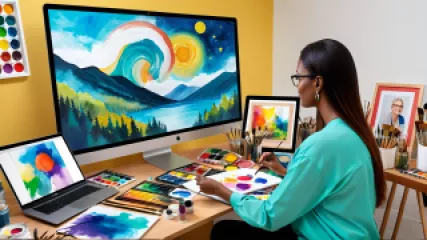How to Host Virtual Art Therapy Sessions
Art therapy is a powerful form of therapy that combines creativity and self-expression to promote healing and personal growth. Traditionally, art therapy sessions have been conducted in person, with therapists providing materials and guiding clients through the creative process. However, with the rise of technology and the increasing demand for virtual services, hosting virtual art therapy sessions has become more popular and accessible. In this tutorial, we will explore how to host virtual art therapy sessions, utilizing innovative therapy approaches and digital tools to create meaningful experiences for clients.
Step 1: Setting Up a Virtual Platform
The first step in hosting virtual art therapy sessions is to choose a suitable platform that allows for video conferencing and screen sharing. There are several options available, such as Zoom, Microsoft Teams, or Google Meet. Consider the features and ease of use when selecting a platform that best fits your needs and the needs of your clients.
Once you have chosen a platform, familiarize yourself with its functionalities, including how to schedule meetings, invite participants, and share screens. It's essential to ensure a smooth and uninterrupted session for both you and your clients.
Step 2: Preparing Materials
Virtual art therapy sessions require careful planning and preparation of materials to ensure that clients can fully engage in the creative process. While clients may have some art supplies at home, it's helpful to provide a list of recommended materials in advance. This list might include:
- Drawing paper or sketchbook
- Pencils, colored pencils, or markers
- Paints (watercolors, acrylics) and brushes
- Modeling clay or playdough
- Collage materials (magazines, scissors, glue)
- Any other specific materials based on the session's theme
Encourage clients to gather their materials before the session and have them easily accessible during the video call. Additionally, consider providing alternative options for clients who may not have access to certain materials.
Step 3: Establishing a Safe and Supportive Environment
Creating a safe, supportive, and confidential environment is crucial in art therapy sessions, whether they are conducted in person or virtually. Prior to starting the session, establish guidelines and expectations for participants, emphasizing confidentiality, respect, and open communication.
Remind clients that their artwork is personal and private, and they have the option to share or keep it to themselves. Encourage open dialogue and active listening to foster a sense of community within the virtual space.
Step 4: Adapting Art Therapy Techniques for Virtual Sessions
While hosting virtual art therapy sessions, it's essential to adapt traditional art therapy techniques to the online environment. Here are a few innovative approaches:
- Guided Visualization: Begin the session with a guided visualization exercise to help clients relax, focus, and tap into their inner creativity. Use descriptive language to guide clients through a calming and inspiring experience.
- Adaptive Art Activities: Modify art activities to suit the virtual setting. For example, instead of using physical materials, clients can create digital collages using online image resources. Encourage experimentation and provide guidance as needed.
- Collaborative Art Projects: Foster connection and collaboration by initiating group art projects. Assign each participant a specific task or element to contribute to a larger piece of artwork. This encourages teamwork and shared creative experiences.
- Virtual Art Galleries: Create virtual galleries to showcase clients' artwork. Utilize screen sharing to display their creations and encourage reflection, discussion, and feedback from both the therapist and other participants.
Step 5: Incorporating Digital Therapy Resources
In addition to traditional art materials, consider incorporating digital therapy resources into your virtual art therapy sessions. These tools can enhance the therapeutic experience and offer new possibilities for self-expression. Here are a few examples:
- Digital Drawing Apps: Recommend digital drawing apps that allow clients to create artwork using tablets or smartphones. These apps often provide a wide range of tools and effects, offering a unique artistic experience.
- Online Image Libraries: Encourage clients to explore online image libraries for inspiration and reference materials. Websites like Unsplash and Pixabay provide a vast collection of high-quality images that clients can use as prompts or incorporate into their artwork.
- Virtual Reality (VR) Art: Explore the potential of virtual reality art platforms that enable clients to immerse themselves in virtual environments and create three-dimensional artwork. VR art can provide a novel and engaging therapeutic experience.
Step 6: Reflecting and Processing
After the creative process, allocate time for reflection and processing. This is a crucial step in art therapy sessions, allowing clients to explore the emotions, symbolism, and meaning behind their artwork. Facilitate open-ended discussions and encourage clients to share their thoughts and insights.
As a therapist, actively listen and provide empathetic support during this reflection phase. Validate clients' experiences and help them gain deeper insights into their own emotions and personal growth.
Step 7: Closing the Session
As the session comes to an end, it's important to close the virtual art therapy session in a meaningful way. Consider the following steps:
- Summary and Recap: Provide a brief summary of the session, highlighting key themes or breakthroughs. Recap any important insights or discussions that occurred during the session.
- Homework or Self-Reflection: Assign homework or self-reflection exercises related to the session's topic. This encourages clients to continue their creative exploration and personal growth outside of the therapy setting.
- Scheduling the Next Session: Discuss the scheduling of the next virtual art therapy session, ensuring that clients have ample time to prepare materials and reflect on their experiences.
Remember to express gratitude to your clients for their participation and openness throughout the session. Ending the session on a positive note reinforces the therapeutic relationship and sets the stage for future sessions.
Hosting virtual art therapy sessions offers a unique opportunity to reach clients in the comfort of their own homes while providing the benefits of creative expression and emotional healing. By following these steps and incorporating innovative therapy approaches and digital tools, you can create engaging and impactful virtual art therapy experiences. Embrace the possibilities of technology and continue to explore new ways to support your clients through online therapy tools and resources.






